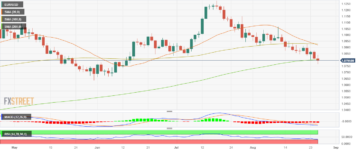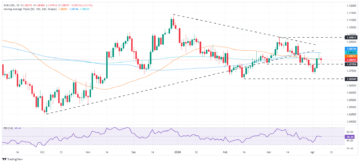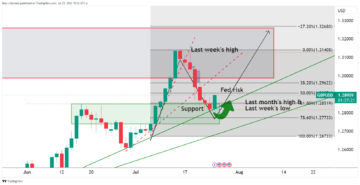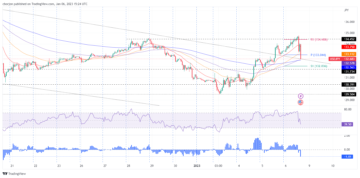- Gold price falls sharply on hot US PPI data for February.
- The US Retail Sales grew by 0.6%, failing to meet expectations.
- Higher US bond yields weigh on the Gold price.
Gold price (XAU/USD) drops sharply in Thursday’s early New York session as the United States Bureau of Labor Statistics (BLS) has reported a hotter-than-anticipated Producer Price Index (PPI) for February. The precious metal has come under pressure as fears of inflation remaining persistent have deepened.
The US February inflation data released on Tuesday came in hotter-than-expected. Now, a similar trend from the PPI data has escalated uncertainty over Federal Reserve (Fed) rate cut expectations for the June policy meeting. This has led yields on 10-year US Treasury bonds higher to 4.27%, resulting in a sharp increase in the opportunity cost of holding non-yielding assets such as Gold. The US Dollar Index (DXY) rises to 103.10, making the Gold price expensive for investors.
Meanwhile, the US Census Bureau has reported that Retail Sales grew slower than market expectations. Going forward, the major trigger for the Gold price will be the Fed’s interest rate decision, and the new dot plot, which provides interest rates projections. The last dot plot, released in the December meeting, indicated three rate cuts this year. due to firm US Dollar (USD) and bond yields
Daily digest market movers: Gold price falls as US yields soar
- Gold price falls to $2,160, pressured by higher US bond yields and firm US Dollar due to stubborn United States PPI data for February. Annual core PPI, which strips off volatile food and energy prices, grew at a steady pace of 2.0%, against expectations of 1.9%. The monthly underlying inflation data rose at a higher pace of 0.3% vs. expectations of 0.2% but remained lower than the prior reading of 0.5%.
- The monthly headline PPI grew strongly by 0.6% against expectations and the former reading of 0.3%. The annual headline PPI accelerated to 1.6% from the consensus of 1.1% and January’s reading of 1.0%%. The PPI data shows the pace at which producers have increased or decreased prices of goods and services at factory gates.
- The stubborn US PPI data has impacted market expectations for Fed rate cuts in June. According to the CME FedWatch tool, the chances in favor of a rate cut in June have dropped to 63% from 69% after the release of the PPI data.
- Meanwhile, the US Census Bureau reported that monthly Retail Sales data grew moderately by 0.6% in February from expectations of 0.8%. In January, the data significantly contracted by 1.1%. Investors closely track the Retail Sales data to gain insights into household spending, one of the main growth drivers of the US economy.
Technical Analysis: Gold price drops to $2,160
Gold price oscillates inside Tuesday’s trading range between $2,154 and $2,180. The precious metal is slowly entering a non-directional trend in which volatility gets sharply contracted. Earlier, the yellow metal dropped after printing a fresh all-time high near $2,195, which coincides with the 1.27% Fibonacci extension level (plotted from December 4 high near $2,145 to December 13 low at $1,973.3).
On the downside, December 4 high near $2,145 and December 28 high at $2,088 will act as major support levels.
The 14-Relative Strength Index (RSI) retraces from its peak near 84.50, although the upside momentum is still active.
Fed FAQs
Monetary policy in the US is shaped by the Federal Reserve (Fed). The Fed has two mandates: to achieve price stability and foster full employment. Its primary tool to achieve these goals is by adjusting interest rates. When prices are rising too quickly and inflation is above the Fed’s 2% target, it raises interest rates, increasing borrowing costs throughout the economy. This results in a stronger US Dollar (USD) as it makes the US a more attractive place for international investors to park their money. When inflation falls below 2% or the Unemployment Rate is too high, the Fed may lower interest rates to encourage borrowing, which weighs on the Greenback.
The Federal Reserve (Fed) holds eight policy meetings a year, where the Federal Open Market Committee (FOMC) assesses economic conditions and makes monetary policy decisions. The FOMC is attended by twelve Fed officials – the seven members of the Board of Governors, the president of the Federal Reserve Bank of New York, and four of the remaining eleven regional Reserve Bank presidents, who serve one-year terms on a rotating basis.
In extreme situations, the Federal Reserve may resort to a policy named Quantitative Easing (QE). QE is the process by which the Fed substantially increases the flow of credit in a stuck financial system. It is a non-standard policy measure used during crises or when inflation is extremely low. It was the Fed’s weapon of choice during the Great Financial Crisis in 2008. It involves the Fed printing more Dollars and using them to buy high grade bonds from financial institutions. QE usually weakens the US Dollar.
Quantitative tightening (QT) is the reverse process of QE, whereby the Federal Reserve stops buying bonds from financial institutions and does not reinvest the principal from the bonds it holds maturing, to purchase new bonds. It is usually positive for the value of the US Dollar.
- SEO Powered Content & PR Distribution. Get Amplified Today.
- PlatoData.Network Vertical Generative Ai. Empower Yourself. Access Here.
- PlatoAiStream. Web3 Intelligence. Knowledge Amplified. Access Here.
- PlatoESG. Carbon, CleanTech, Energy, Environment, Solar, Waste Management. Access Here.
- PlatoHealth. Biotech and Clinical Trials Intelligence. Access Here.
- Source: https://www.fxstreet.com/news/gold-price-treads-with-caution-ahead-of-us-ppi-retail-sales-202403141043
- :has
- :is
- :not
- :where
- 1
- 10
- 13
- 160
- 180
- 195
- 2%
- 20
- 2008
- 28
- 4
- 50
- 6
- 84
- 9
- a
- above
- accelerated
- According
- Achieve
- Act
- active
- adjusting
- After
- against
- Although
- analysis
- and
- annual
- ARE
- AS
- assesses
- Assets
- At
- attractive
- Bank
- basis
- BE
- below
- Bets
- between
- board
- bond
- Bond yields
- Bonds
- Borrowing
- Bureau
- bureau of labor statistics
- but
- buy
- Buying
- by
- came
- Census
- Census Bureau
- chances
- checked
- choice
- closely
- CME
- coincides
- come
- committee
- conditions
- Consensus
- Core
- Cost
- Costs
- credit
- crises
- crisis
- Cut
- cuts
- data
- December
- decision
- decisions
- decreased
- Digest
- does
- Dollar
- dollars
- DOT
- downside
- drivers
- dropped
- Drops
- due
- during
- Dxy
- Earlier
- Early
- easing
- Economic
- Economic Conditions
- economy
- eight
- eleven
- employment
- encourage
- energy
- energy prices
- entering
- expectations
- expensive
- extension
- extreme
- extremely
- factory
- failing
- Falls
- FAQ
- favor
- fears
- February
- Fed
- Federal
- Federal Open Market Committee
- federal reserve
- Federal Reserve Bank
- Federal Reserve Bank of New York
- financial
- financial crisis
- Financial institutions
- financial system
- Firm
- flow
- FOMC
- food
- For
- For Investors
- forex
- Former
- Forward
- Foster
- four
- fresh
- from
- full
- Gain
- Gates
- gets
- Goals
- going
- Gold
- gold price
- goods
- governors
- grade
- great
- Greenback
- grew
- Growth
- Have
- headline
- High
- higher
- holding
- holds
- HOT
- household
- HTTPS
- impacted
- in
- Increase
- increased
- Increases
- increasing
- index
- indicated
- inflation
- inside
- insights
- institutions
- interest
- INTEREST RATE
- Interest Rates
- International
- international investors
- into
- Investors
- involves
- IT
- ITS
- January
- june
- labor
- Last
- Led
- Level
- levels
- Low
- lower
- Main
- major
- MAKES
- Making
- mandates
- Market
- May..
- measure
- Meet
- meeting
- meetings
- Members
- metal
- Momentum
- Monetary
- Monetary Policy
- money
- monthly
- more
- Movers
- Named
- Near
- New
- New York
- now
- of
- off
- officials
- on
- ONE
- open
- Opportunity
- or
- over
- Pace
- Park
- Peak
- Place
- plato
- Plato Data Intelligence
- PlatoData
- plot
- policy
- positive
- ppi
- Precious
- president
- Presidents
- pressure
- price
- Prices
- primary
- Principal
- printing
- Prior
- process
- Producers
- projections
- provides
- purchase
- QE
- QT
- quantitative
- Quantitative Easing
- quickly
- raises
- range
- Rate
- Rates
- Reading
- regional
- reinvest
- release
- released
- remained
- remaining
- Reported
- Reserve
- reserve bank
- Resort
- Results
- retail
- Retail Sales
- reverse
- Rises
- rising
- ROSE
- rsi
- s
- sales
- serve
- Services
- session
- seven
- shaped
- Shows
- significantly
- similar
- situations
- slower
- Slowly
- Spending
- Stability
- States
- statistics
- steady
- Still
- Stops
- strength
- stronger
- strongly
- stuck
- substantially
- such
- support
- support levels
- system
- Target
- terms
- than
- that
- The
- the Fed
- their
- Them
- These
- this
- this year
- three
- throughout
- tightening
- to
- too
- tool
- track
- Traders
- Trading
- treasury
- Trend
- trigger
- Tuesday
- Tumbles
- two
- Uncertainty
- under
- underlying
- unemployment
- unemployment rate
- United
- United States
- Upside
- us
- US bond yields
- US Census
- US Dollar
- US economy
- US PPI
- US Retail Sales
- US Treasury
- US yields
- USD
- used
- using
- usually
- v1
- value
- volatile
- Volatility
- vs
- was
- weigh
- weighs
- when
- which
- WHO
- will
- with
- XAU/USD
- year
- yellow
- yields
- york
- zephyrnet













